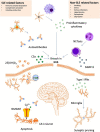Cognitive Dysfunction in Systemic Lupus Erythematosus: Immunopathology, Clinical Manifestations, Neuroimaging and Management
- PMID: 33993432
- PMCID: PMC8217391
- DOI: 10.1007/s40744-021-00312-0
Cognitive Dysfunction in Systemic Lupus Erythematosus: Immunopathology, Clinical Manifestations, Neuroimaging and Management
Abstract
Cognitive dysfunction (CD) is a common yet often clinically subtle manifestation that considerably impacts the health-related quality of life in patients with systemic lupus erythaematosus (SLE). Given the inconsistencies in CD assessment and challenges in its attribution to SLE, the reported prevalence of CD differs widely, ranging from 3 to 88%. The clinical presentation of CD in SLE is non-specific and may manifest concurrently with overt neuropsychiatric illness such as psychosis or mood disorders or as isolated impairment of attention, working memory, executive dysfunction or processing speed. Despite the lack of standardized and sensitive neuropsychological tests and validated diagnostic biomarkers of CD in SLE, significant progress has been made in identifying pathogenic neural pathways and neuroimaging. Furthermore, several autoantibodies, cytokines, pro-inflammatory mediators and metabolic factors have been implicated in the pathogenesis of CD in SLE. Abrogation of the integrity of the blood-brain barrier (BBB) and ensuing autoantibody-mediated neurotoxicity, complement and microglial activation remains the widely accepted mechanism of SLE-related CD. Although several functional neuroimaging modalities have consistently demonstrated abnormalities that correlate with CD in SLE patients, a consensus remains to be reached as to their clinical utility in diagnosing CD. Given the multifactorial aetiology of CD, a multi-domain interventional approach that addresses the risk factors and disease mechanisms of CD in a concurrent fashion is the favourable therapeutic direction. While cognitive rehabilitation and exercise training remain important, specific pharmacological agents that target microglial activation and maintain the BBB integrity are potential candidates for the treatment of SLE-related CD.
Keywords: Cognitive; Glucocorticoids; Imaging; Lupus; Neuropsychiatric; Systemic lupus erythematosus.
Figures



Similar articles
-
Cognitive Dysfunction in Systemic Lupus Erythematosus: A Case for Initiating Trials.Arthritis Rheumatol. 2019 Sep;71(9):1413-1425. doi: 10.1002/art.40933. Epub 2019 Aug 7. Arthritis Rheumatol. 2019. PMID: 31102496 Free PMC article. Review.
-
Advanced neuroimaging in systemic lupus erythematosus: identifying biomarkers for cognitive dysfunction.Neuroradiology. 2025 Apr 28. doi: 10.1007/s00234-025-03619-9. Online ahead of print. Neuroradiology. 2025. PMID: 40293471 Review.
-
Effects of systemic lupus erythematosus on the brain: a systematic review of structural MRI findings and their relationships with cognitive dysfunction.Lupus Sci Med. 2024 Aug 17;11(2):e001214. doi: 10.1136/lupus-2024-001214. Lupus Sci Med. 2024. PMID: 39153821 Free PMC article.
-
Anti-NR2 antibodies, blood-brain barrier, and cognitive dysfunction.Clin Rheumatol. 2016 Dec;35(12):2989-2997. doi: 10.1007/s10067-016-3339-1. Epub 2016 Jun 29. Clin Rheumatol. 2016. PMID: 27357716
-
Neurological Manifestations of Systemic Lupus Erythematosus: A Comprehensive Review.Cureus. 2025 Feb 24;17(2):e79569. doi: 10.7759/cureus.79569. eCollection 2025 Feb. Cureus. 2025. PMID: 40151747 Free PMC article. Review.
Cited by
-
Lupus nephritis: The regulatory interplay between epigenetic and MicroRNAs.Front Physiol. 2022 Sep 16;13:925416. doi: 10.3389/fphys.2022.925416. eCollection 2022. Front Physiol. 2022. PMID: 36187762 Free PMC article. Review.
-
Role of autoantibodies and blood-brain barrier leakage in cognitive impairment in systemic lupus erythematosus.Lupus Sci Med. 2022 Jun;9(1):e000668. doi: 10.1136/lupus-2022-000668. Lupus Sci Med. 2022. PMID: 35705307 Free PMC article.
-
Decoding Autoimmunity: Insights Into Neuromyelitis Optica and Its Relationship With Other Autoimmune Neurological Disorders.Cureus. 2025 Apr 11;17(4):e82062. doi: 10.7759/cureus.82062. eCollection 2025 Apr. Cureus. 2025. PMID: 40352054 Free PMC article. Review.
-
Psychological Implications to the Therapy of Systemic Lupus Erythematosus.Int J Environ Res Public Health. 2022 Nov 30;19(23):16021. doi: 10.3390/ijerph192316021. Int J Environ Res Public Health. 2022. PMID: 36498095 Free PMC article. Review.
-
Altered medial temporal lobe subregion volumes in systemic lupus erythematosus patients with neuropsychiatric symptoms.BMC Rheumatol. 2025 Jan 26;9(1):10. doi: 10.1186/s41927-024-00448-w. BMC Rheumatol. 2025. PMID: 39865321 Free PMC article.
References
-
- Sanna G, Bertolaccini ML, Khamashta MA. Neuropsychiatric involvement in systemic lupus erythematosus: current therapeutic approach. Curr Pharm Des. 2008;14(13):1261–1269. - PubMed
-
- The American College of Rheumatology nomenclature and case definitions for neuropsychiatric lupus syndromes. Arthritis Rheum. 1999;42(4):599–608. - PubMed
-
- Sanna G, Bertolaccini ML, Cuadrado MJ, Laing H, Khamashta MA, Mathieu A, et al. Neuropsychiatric manifestations in systemic lupus erythematosus: prevalence and association with antiphospholipid antibodies. J Rheumatol. 2003;30(5):985–992. - PubMed
-
- Brey RL, Holliday SL, Saklad AR, Navarrete MG, Hermosillo-Romo D, Stallworth CL, et al. Neuropsychiatric syndromes in lupus: prevalence using standardized definitions. Neurology. 2002;58(8):1214–1220. - PubMed
-
- Zhou HQ, Zhang FC, Tian XP, Leng XM, Lu JJ, Zhao Y, et al. Clinical features and outcome of neuropsychiatric lupus in Chinese: analysis of 240 hospitalized patients. Lupus. 2008;17(2):93–99. - PubMed
Publication types
LinkOut - more resources
Full Text Sources
Other Literature Sources

